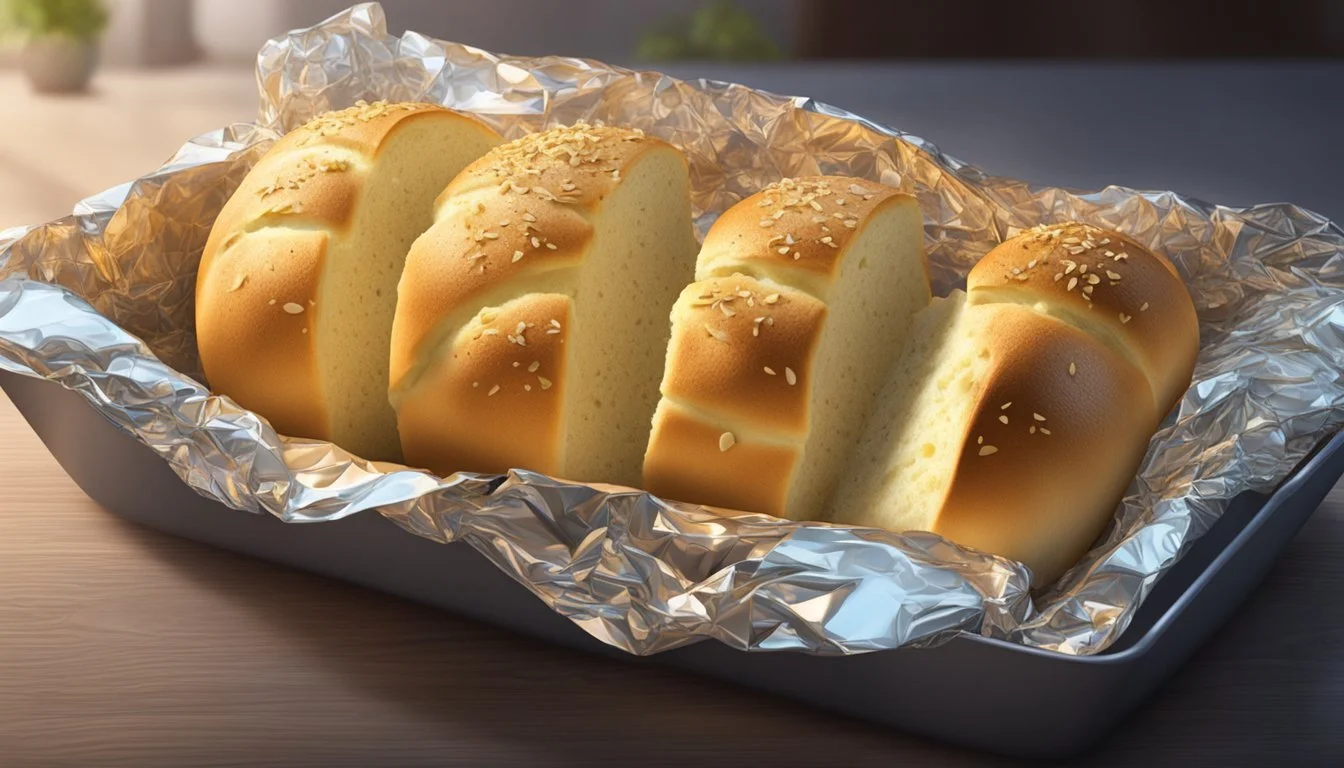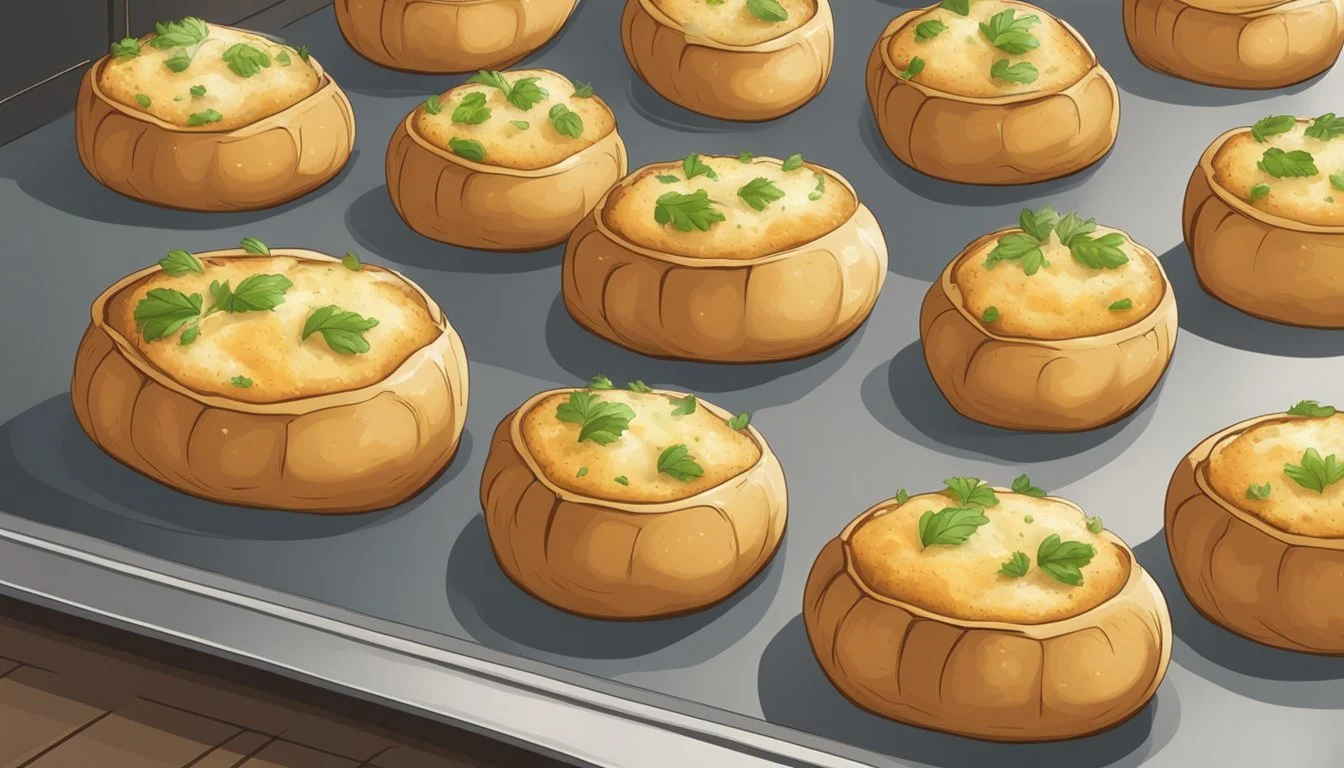Best Way to Reheat Garlic Bread
Ensuring a Crispy Exterior and Soft Center
Garlic (What wine goes well with garlic?) bread (What wine goes well with bread?) is a beloved side dish renowned for its fragrant aroma and delightful combination of a crispy exterior and a soft, buttery interior. Achieving the perfect balance of textures when reheating garlic bread is crucial to recreating the experience of freshly baked goodness. Many people struggle with this task, often ending up with bread that is either too hard or too soggy.
To ensure that garlic bread retains its textural contrast upon reheating, specific methods should be employed. These techniques are designed to gently warm the bread while preserving its moisture and crispness. Some methods involve using an oven or a toaster oven, which circulates heat evenly around the bread, achieving a consistent temperature that reliably restores the bread's original qualities. Microwave reheating, often discouraged due to its tendency to create a rubbery texture, can still be used with careful attention to timing and the addition of a cup of water to maintain humidity.
Understanding Garlic Bread
Garlic bread is a beloved side dish known for its alluring scent and delightful combination of flavors and textures. Achieving the perfect texture is crucial to its enjoyment.
Components of Garlic Bread
Garlic bread typically consists of a baguette or ciabatta bread sliced open, coated with a mixture of butter, minced garlic, and often cheese. The bread is then toasted until the butter is melted and the surface becomes crispy. The key elements that bring garlic bread to life include:
Bread: Serves as the base and provides structure.
Butter or Oil: Adds moisture and helps develop a crisp crust when heated.
Garlic: Delivers the signature flavor.
Cheese (optional): Enhances flavor and can contribute to the texture with a gooey or crispy layer.
Herbs (e.g., parsley): Offer an additional flavor dimension.
A balance between these components leads to a flavorful and texturally satisfying garlic bread.
Importance of Texture
The texture of garlic bread is a sensory experience that signifies freshness and quality. For an optimal eating experience, the crust should be crispy to the touch, while the interior remains soft and fluffy. The distinct textural contrast is achieved through:
Temperature: High heat is important to develop a crisp crust.
Moisture Level: Too much moisture can prevent the bread from achieving the desired crispness.
Reheating Method: Selecting the right reheating technique is critical to maintaining or restoring the texture without compromising the flavor.
Understanding the elements and significance of texture can guide one towards reheating garlic bread in a way that preserves its essence.
Storing Garlic Bread
Proper storage is crucial for maintaining the quality and freshness of leftover garlic bread. Whether one opts for freezing or refrigeration, the key is to protect the bread from moisture and air.
Freezing and Refrigeration
Freezing: To freeze garlic bread, one should:
Wrap the bread tightly in aluminum foil or plastic wrap.
Place the wrapped bread in a heavy-duty freezer bag to prevent freezer burn.
Label the bag with the date, as frozen garlic bread maintains optimal quality for up to 3 months.
Refrigeration: For short-term storage in the fridge:
Put the garlic bread in a plastic container or wrap it with foil.
Consume refrigerated garlic bread within 2 days to ensure it remains fresh and to avoid staleness.
Preventing Moisture Loss
Maintaining the bread's moisture balance is essential for retaining its soft texture. Here are steps to prevent moisture loss:
At Room Temperature: Store garlic bread in a bread box or airtight container for 1-2 days.
In Freezer or Fridge: Ensure the bread is sealed tightly in a container or bag. Squeeze out excess air before sealing to minimize moisture loss and stave off staleness.
Reheating Methods
Choosing the right reheating method for garlic bread can make the difference between a perfectly crispy crust with a soft interior and a disappointing texture.
Oven Method
Preheat your oven to 350°F (175°C). For whole loaves, wrap the garlic bread in aluminum foil to prevent burning and ensure even heat distribution. Place the bread on a baking sheet and heat for approximately 10-15 minutes. Sliced garlic bread can be placed directly on the baking sheet, butter side up, for quicker reheating—about 5-7 minutes should suffice.
Toaster Oven Method
Set the toaster oven to a low-medium heat setting, around 300°F (150°C). If you're reheating sliced garlic bread, it can go directly on the rack or on a small baking sheet. Reheat for 5-7 minutes, flipping once to ensure each side gets crispy.
Stovetop Skillet Method
A skillet on the stove can serve well for reheating garlic bread with a toasted effect. Heat a skillet over low heat. If the bread is already sliced, place slices directly in the pan and cover loosely with a lid to maintain moisture inside the bread. Heat each side for 1-2 minutes, or until the desired crispness is achieved.
Microwave Reheating
Although not ideal for crispiness, a microwave can quickly reheat garlic bread. Place the slices on a microwave-safe plate, optionally covering them with a damp paper towel to keep the bread moist. Reheat in 10-second intervals, checking frequently, for no more than 30 seconds total.
Air Fryer Technique
Preheat the air fryer to 350°F (175°C). Place garlic bread slices in a single layer in the air fryer basket. Heat for 3-4 minutes, or until the outside is adequately crispy and the inside remains soft. Avoid overcrowding the basket to ensure even circulation of hot air for the crispiest results.
Best Practices for Reheating
When reheating garlic bread, the goals are to maintain its appealing texture—crisp on the outside, soft on the inside—and to preserve its fresh flavor.
Achieving Crispiness
Toaster Oven:
Preheat to 300°F (150°C).
Place slices directly on the rack or a baking sheet.
Heat for 5-7 minutes, flipping once.
Oven:
Preheat to 350°F.
Wrap bread in foil.
Bake for 10 minutes.
Retaining Soft Interior
Microwave:
Cut bread into slices.
Cover with a damp paper towel.
Heat in 10-second intervals, up to 30 seconds.
Aluminum Foil:
Wrap bread in foil to create an even heat distribution.
This method prevents drying out, retaining the soft, fresh interior.
Balancing Heat and Time
Toaster Oven: Monitor closely to prevent burning.
Oven: Wrapping in foil affords better control over texture balance.
Microwave: Use sparingly—minimal time prevents hardening.
Serving and Pairing
Properly reheated garlic bread offers a versatile side that complements a variety of meals. The key is pairing it with dishes that allow the garlic bread's crispy exterior and soft, buttery interior to shine through.
Complementing Meals
Garlic bread pairs excellently with pasta dishes, especially those rich in tomato-based sauces, such as spaghetti or lasagna. The bread's robust garlic flavor also makes it a welcome addition alongside soups, like a classic minestrone or creamy chowders. For a wholesome meal, consider serving garlic bread alongside a crisp salad, using the bread to add a satisfying crunch.
Suggested Meal Combinations:
Pasta: Spaghetti Bolognese, Fettuccine Alfredo, Penne alla Vodka
Soups: Tomato Soup, Broccoli Cheddar Soup, Italian Wedding Soup
Salads: Caesar Salad, Antipasto Salad, Greek Salad
Adding Final Touches
To elevate the flavor profile of garlic bread, one can brush it with melted butter before the final stretch of reheating. Sprinkling freshly grated cheese such as parmesan or mozzarella over the warm bread adds a savory depth and allows the cheese to melt into the crevices. A light garnish of fresh herbs, like parsley or basil, can impart a complementary freshness that balances the intensity of the garlic butter.
Enhancement Tips:
Cheeses: Parmesan, Mozzarella, Asiago
Herbs: Parsley, Basil, Oregano
Butters: Garlic butter, Herb-infused butter
Serve the garlic bread immediately after reheating to enjoy its optimal taste and texture, ensuring a delightful addition to any meal.
Troubleshooting Common Issues
When reheating garlic bread, one may encounter a few common problems that can affect its taste and texture. This section is dedicated to addressing these issues and providing solutions to ensure reheated garlic bread remains crispy on the outside and soft on the inside.
Preventing Sogginess
Reheating garlic bread can often result in a soggy texture, which diminishes its appeal. To prevent this:
Wrap the bread in aluminum foil to trap the moisture and maintain a soft interior while the outside crisps up.
Place a heatproof container with water in the oven when reheating, especially for sliced garlic bread, to introduce moisture and prevent drying out which might otherwise lead to toughness.
Dealing with Overcooking
Overcooking is a common mistake that can lead to hard and unpalatable garlic bread. To deal with this:
When using a microwave, heat the garlic bread in short 10-second bursts to avoid overcooking, checking it after each interval.
For frozen garlic bread, reduce the reheating time as it requires less heat to reach the desired warmth compared to leftovers that have been stored at room temperature.
Restoring Stale Garlic Bread
Stale garlic bread can lose its flavor and delights, but with the right techniques, one can restore its quality:
Oven reheating is the most effective method to restore stale bread. Preheat the oven and wrap the bread in foil before placing it inside. This method helps to recapture the bread's original crispy exterior and soft interior.
If the bread is very dry, spritz it lightly with water before wrapping it in foil, which will help refresh the bread without making it soggy.
Health and Safety Considerations
When reheating garlic bread, it is essential to consider both health and safety to prevent foodborne illness and to maintain the nutritional integrity of the bread. Proper handling and reheating methods can help ensure that your garlic bread remains a safe and enjoyable dish.
Food Safety Guidelines
Reheating Temperature: Garlic bread should be reheated to an internal temperature of 165°F to ensure that it is safe to eat. Use a food thermometer to check the temperature.
Storage: Leftover garlic bread should be stored in an airtight container and refrigerated within two hours of cooking.
Shelf Life: Refrigerated garlic bread should be consumed within 3-4 days. Cheesy garlic bread or garlic cheese bread, due to its higher protein content, may spoil faster.
Cross-Contamination: Avoid using the same utensils or cutting boards for raw and cooked foods without proper washing to prevent cross-contamination.
Nutritional Information
Calories and Macronutrients: When you reheat garlic bread, especially if it’s cheesy garlic bread, remember:
Caloric impact: Cheesy garlic bread is generally higher in calories due to the addition of cheese.
Carbohydrates: Garlic bread primarily provides carbohydrates; whole grain versions offer more fiber.
Fats: Reheating methods do not significantly alter the fat content, but overcooking can affect texture and possibly the breakdown of some nutrients.




